Ballet jumps are a fundamental element in classical dance and are used in rehearsals and performances. Although most of us are not born with an innate talent for jumping, this talent can indeed be developed with the right training. So, in this article, we will tell you some tips to improve their execution.
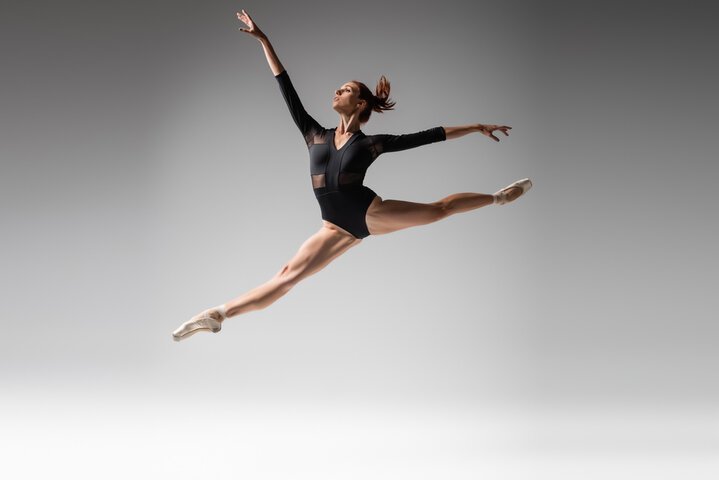
Table of Contents
The perfect jump
We will then see that they share many characteristics whatever the type of jump. It should always be light and off the ground, except in cases where characterising your role requires something different. In ballet, jumps are not uncontrolled bounces.
From a deep demi-plie, there is a strong push-off from the floor. So, the thigh muscles contract, and your knees straighten as the feet leave the floor by a firm push through the insteps and toes. In the air, your body is aligned, abdominal muscles lengthened upward, your toes straightened, and your feet fully arched.
Finally, you land on the ground smoothly and with full control. Never descend like a dead weight. Then roll down through the balls and soles of the feet to the heels, allowing the knees to bend into the demi-plie and keeping the pelvis from tilting forward.
Of course, this is accompanied by the appropriate épaulement and port de bras. Last but not least, remember that breathing is also essential. Inhale as you rise and exhale as you descend.
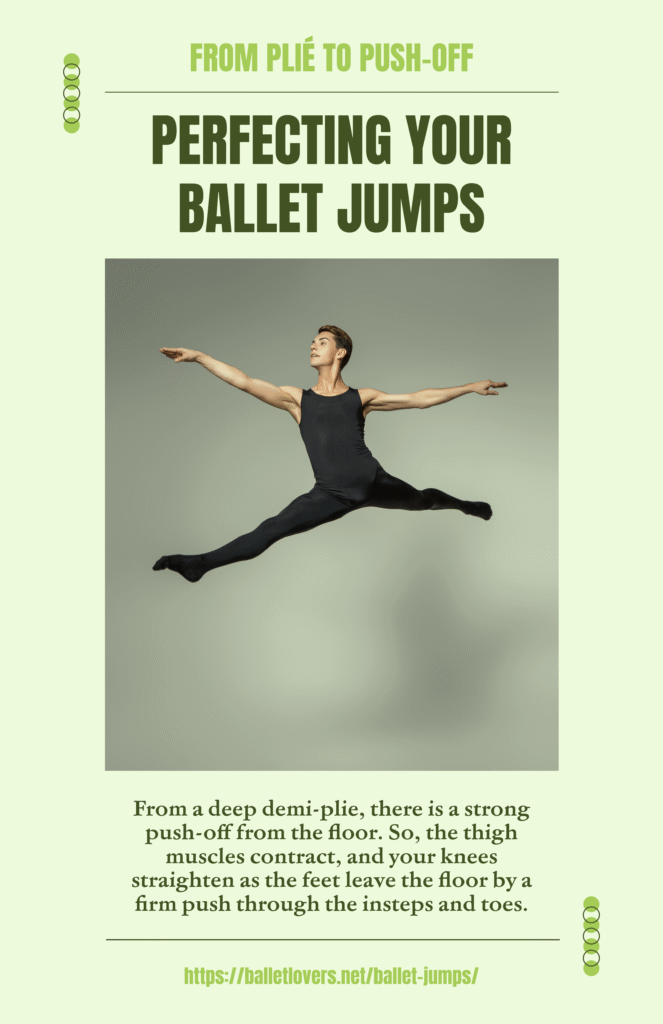
The Importance of Plié
Every jump begins and ends in the plié, which performs a function similar to that of a spring or trampoline. The plié will give the dancer the energy and push-off necessary to soar. To do this, the dancer will use the muscles of his hips, thighs, calves and feet, pushing off the ground to elevate into the air. However, in the case of jumps executed at a very fast pace, the plié almost completely disappears. This usually occurs in the “Petit Allegro”, in which dancers must transfer their weight extraordinarily quickly from one movement to the next.
Since the main factor imparting force at the moment of takeoff from the ground is the heel, it is necessary, in the development of the jump, to pay special attention to the correctness of the demi-plié. Do your best to keep your heels from lifting off the ground in the demi-plié.
The plié must be continuous and without pause; it never stops. And when descending, the plie must be as deep as the previous plié, providing a cushion for landing from the jump. Finally, the plié provides a shock absorber for the body, preventing injury to the back, hip, knee, and ankle joints.
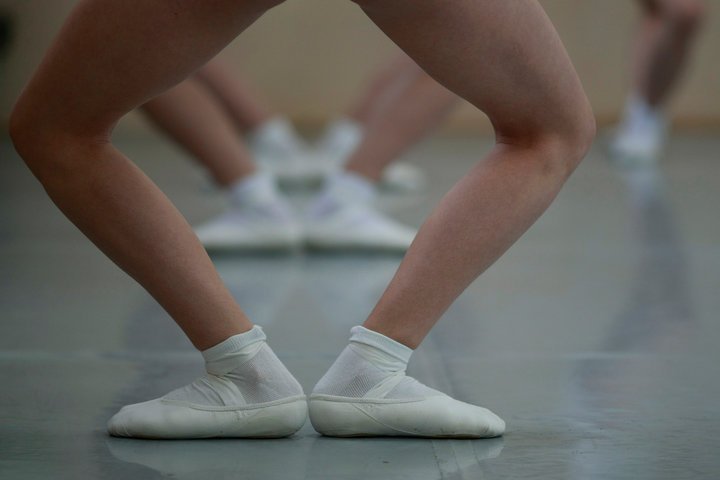
Your Toes and Heels
In plié, before jumping with both feet, you have to lift your heels off the ground. Otherwise, it will be very difficult for you to get up. When pushing off from the ground, point your feet quickly, including the tips of your toes
When landing, your feet should touch the ground first with the toes, then gently with the heel, then lower into the demi-plié position. Finally, straighten your knees. To achieve this great control, you will need to develop the strength of your thighs, calves, ankles, and feet. Only if you are performing a sequence of jumps at a swift tempo (a petit allegro, for example) could you skip landing your heels on the ground to achieve greater speed.
Don’t land on your entire foot. The weight remains concentrated on the ball of the foot. On the contrary, if you put your weight on your heels, the movement will stop. The heels act as brakes, so they should hardly be supported. So, you should only firmly support your heel at the end of a series of jumps to stop the movement.
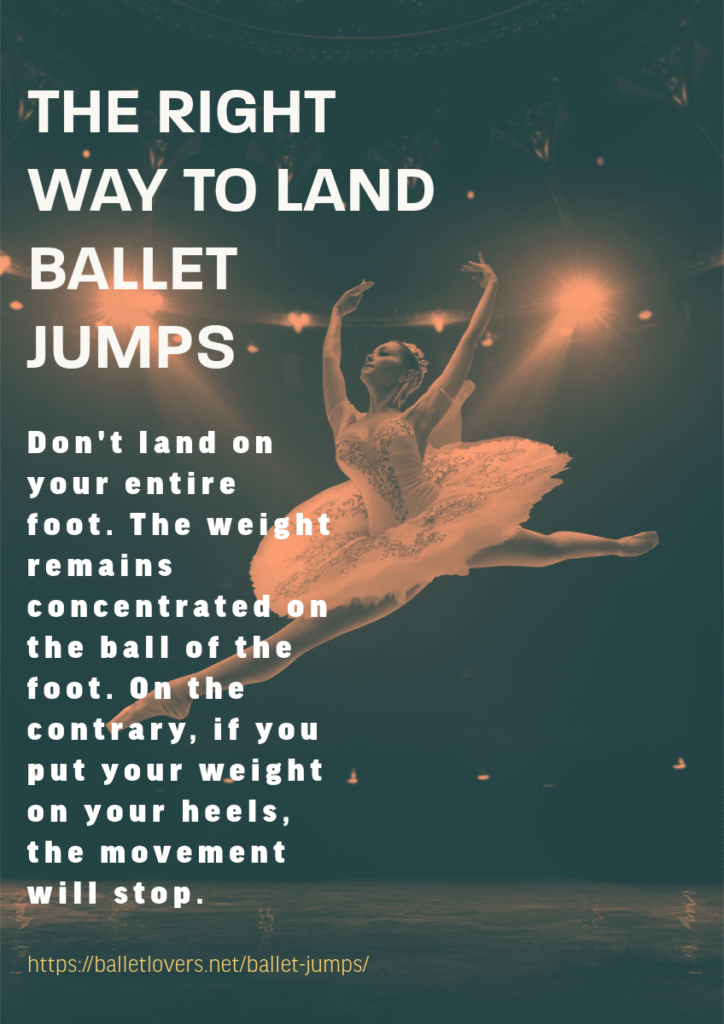
Your Upper Body
In jumps, the arms serve a dual function. On the one hand, they contribute to the beauty of the movement. And on the other hand, they help in its execution.
How should you position your arms? If you are a beginner, you may keep your arms in a preparatory position to concentrate on the lower body.
But usually, when the legs are spread out in jumps, the arms are spread out as well. On the contrary, when the legs are closed in the air, the arms are also closed. This is because the arm movements help provide push-off on takeoff, give stability to the pose on landing, and create additional lift and strength during movements performed in the air.
KEY INFO
Another generally accepted maxim is that small, low arm movements accompany small jumps. And large jumps by higher, more expansive movements.
Finally, the port de bras during jumps must be performed without tension. It is common for dancers to express the force of a jump through unnecessary tension in their arms, hands, neck and shoulders. This negatively affects the aesthetics of the movement. This tension in the upper body makes the jump appear forced and heavy, rather than light and fluid. A relaxed and controlled port de bras, on the contrary, contributes to the feeling of suspension in the air, a constant goal of every dancer.
What is ballon in ballet jumps?
While in the air, the dancer usually adopts a position or pose. This is what we know in dance as a ballon.
By the term ballon, we mean the ability of a dancer to maintain in the air a pose or position that is habitual for him on the ground. The dancer stops in the air, staying there as if defying gravity. So, when we talk about classical elevation we are referring to high jumps related to the ballon.
The term “ballon” is fundamental in the world of ballet, especially in allegro movements. When we say a dancer has “good ballon,” we are referring to their ability to leave the floor lightly, remain suspended in the air for a moment, and land with a softness reminiscent of a bouncing rubber ball.
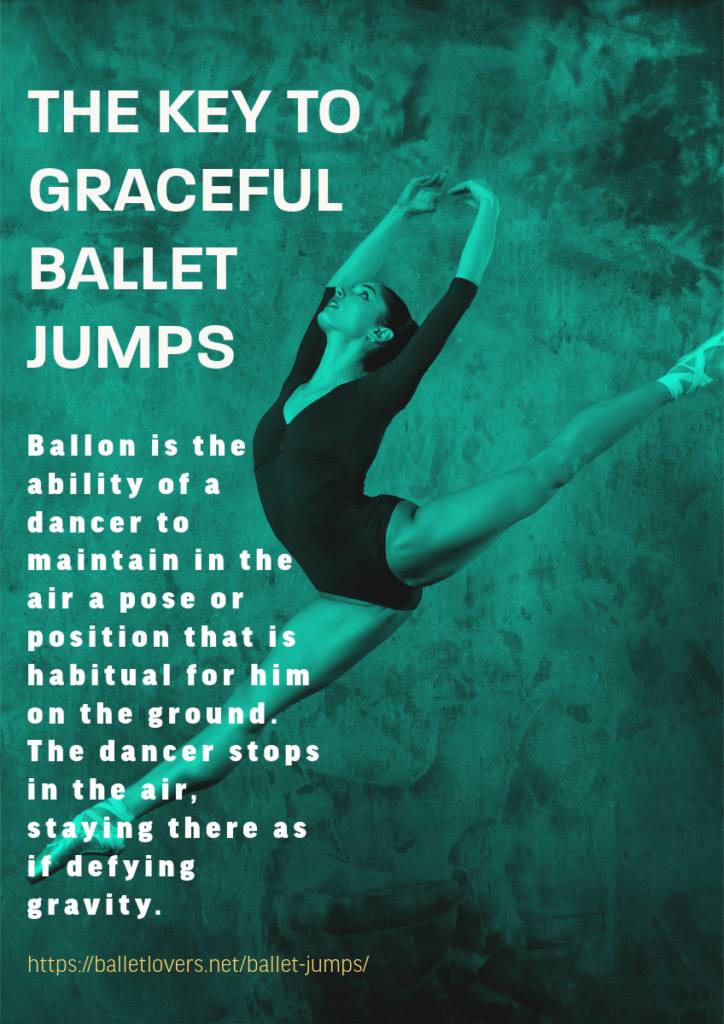
This quality is what makes the dancer appear to float, free from gravity, unlike those without a ballon, which give a sensation of heaviness and seem glued to the floor. As you can see, this lightness is vital for any dancer.
It is crucial to understand that ballon is not a natural gift. Although some people have an innate aptitude for jumping higher, this technique is developed through rigorous and precise training.
KEY INFO
Ballon is perfected through the correct use of the insteps, the elasticity of the knees, and the strengthening of the Achilles tendons. In short, it is the result of effort and dedication, not just genetics.
How to learn ballet jumps
The barre is used to help the dancer maintain stability. All ballet movements, including jumps, must first be studied at the barre. In the case of jumps, the barre will help you stay in the air long enough to concentrate on feeling the correct position of your legs in the air. After practising the jump at the barre for several classes, you can move to the centre to try the step without support.
KEY INFO
On the other hand, working on the fondu at the barre is also essential. Perfecting this movement will greatly help you improve jumps that require landing on one leg.
Besides, the study of jumps is approached gradually. Without a doubt, the simplest jump is the temps levé and is so the first one to be learned. Here are some examples of different jumps according to level, from the simplest to the most complex:
Beginner
- Temps Levé in all positions
- Changement de pied
- Échappé
- Sissone simple
- Assemblé
Intermediate
- Soubresaut
- Temps levé on one leg
- Royale
- Jeté passé at 45°
- Assemblé battu
- Brisé en avant and en arriére
- Grand Assemblé
- Sissone simple en tournant
Advanced
- Cabriole at 45°
- Grand assemblé en tournant
- Grand Jeté
- Grande cabriole
- Grand fouetté sauté
- Grand jeté en tournant
- Double tour en l’air in retiré landing on one leg (men)
To sum up, the first and easiest jumps to learn are the small jumps performed on two feet and landed on two feet. For example, the temps levé. Next, you should study jumps from two feet onto one foot. These need considerable control when landing and include jumps such as the sissonnes. At the same time, students learn jumps performed on one foot and landed on two, such as the tombe assemblé. Finally, the most difficult are those where the dancer pushes off with one foot and lands on the same foot.
Learn the basic movements here:
Why is it important to respect this order when learning jumps?
Each jump is a specific exercise to develop a certain strength. The jumps are linked in an orderly progression, preparing your body for the grand allegro, which requires a considerable amount of strength. Executing a jump for which your body is not yet ready could be dangerous.
Which muscles should you work to improve your jumps?
The muscles of the knee and thigh are crucial. However, the Achilles tendon is undoubtedly the primary muscle responsible for elevation. The Achilles tendon behaves like a spring, stretching and contracting. The greater the stretch, the greater the contraction that conditions the push off the ground.
How can you improve the elasticity of the Achilles tendon?
To improve Achilles tendon elasticity, perform demi-pliés with both hands on the barre. Concentrate on rotating from the hip and avoid lifting your heels.
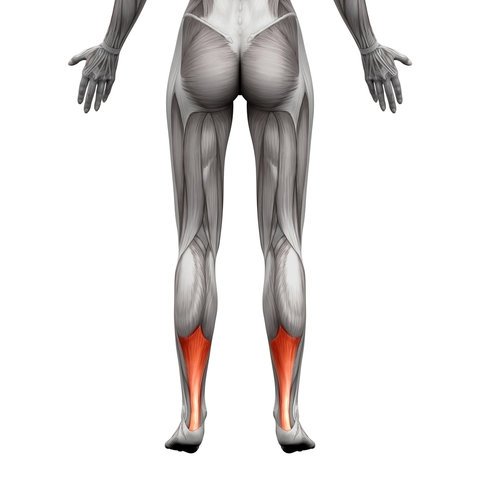





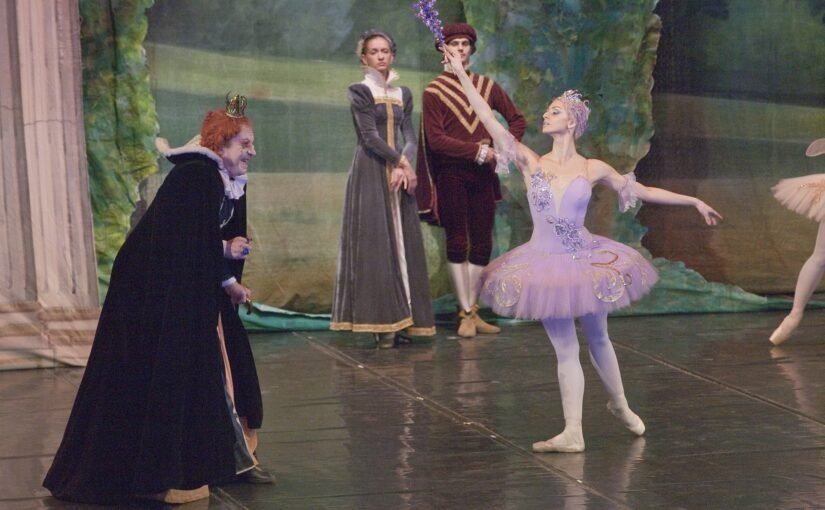
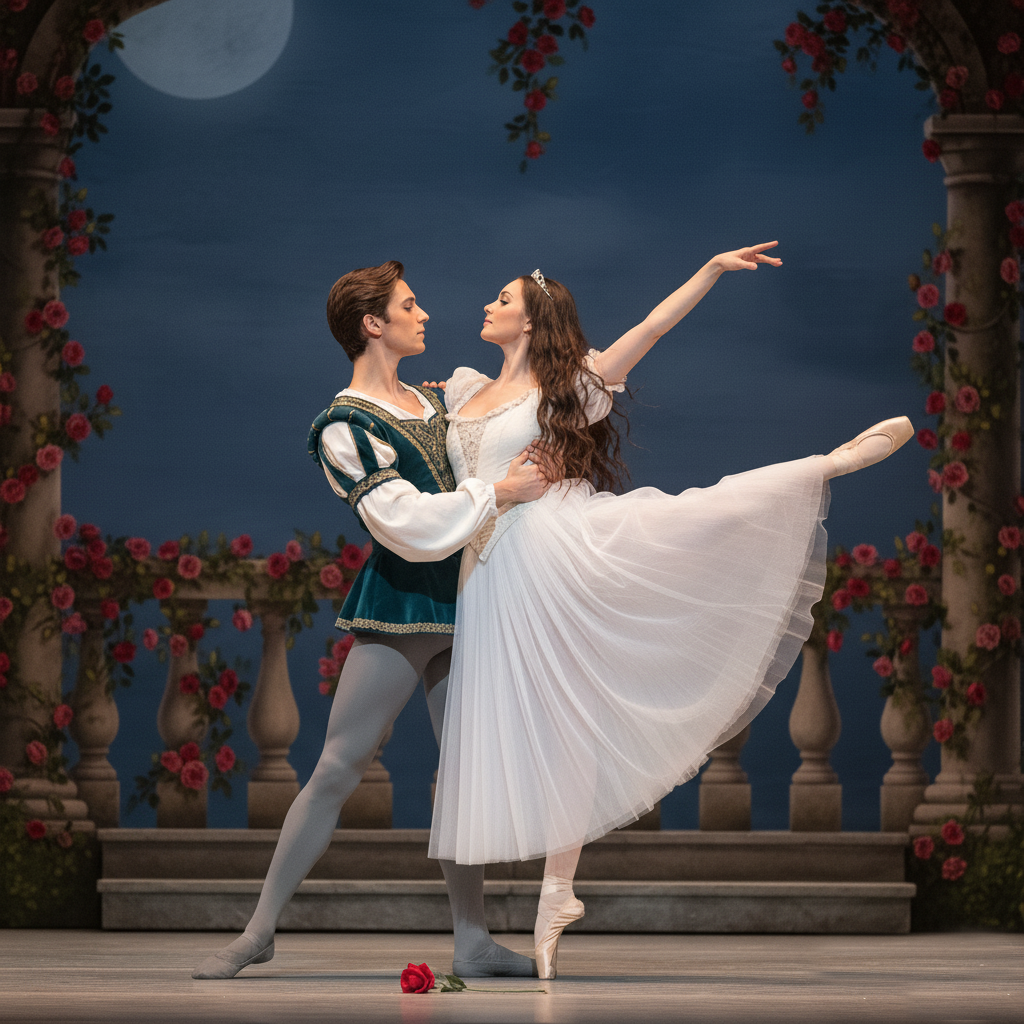
Leave a Reply